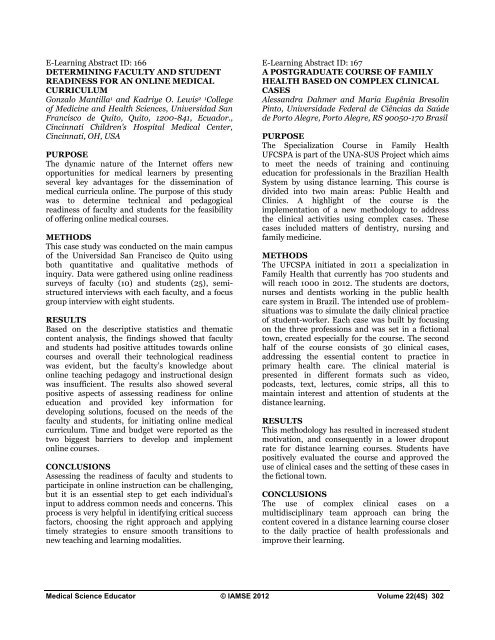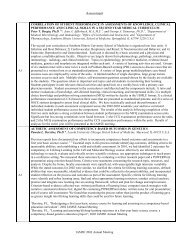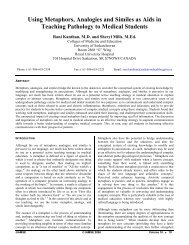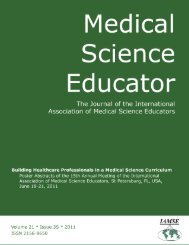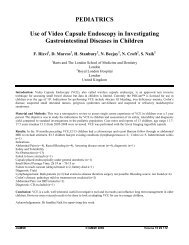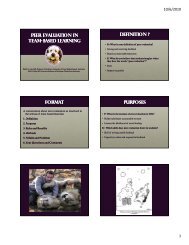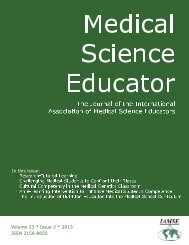Click here to view complete journal in pdf-format - IAMSE
Click here to view complete journal in pdf-format - IAMSE
Click here to view complete journal in pdf-format - IAMSE
Create successful ePaper yourself
Turn your PDF publications into a flip-book with our unique Google optimized e-Paper software.
E-Learn<strong>in</strong>g Abstract ID: 166<br />
DETERMINING FACULTY AND STUDENT<br />
READINESS FOR AN ONLINE MEDICAL<br />
CURRICULUM<br />
Gonzalo Mantilla 1 and Kadriye O. Lewis 2 1 College<br />
of Medic<strong>in</strong>e and Health Sciences, Universidad San<br />
Francisco de Qui<strong>to</strong>, Qui<strong>to</strong>, 1200-841, Ecuador.,<br />
C<strong>in</strong>c<strong>in</strong>nati Children’s Hospital Medical Center,<br />
C<strong>in</strong>c<strong>in</strong>nati, OH, USA<br />
PURPOSE<br />
The dynamic nature of the Internet offers new<br />
opportunities for medical learners by present<strong>in</strong>g<br />
several key advantages for the dissem<strong>in</strong>ation of<br />
medical curricula onl<strong>in</strong>e. The purpose of this study<br />
was <strong>to</strong> determ<strong>in</strong>e technical and pedagogical<br />
read<strong>in</strong>ess of faculty and students for the feasibility<br />
of offer<strong>in</strong>g onl<strong>in</strong>e medical courses.<br />
METHODS<br />
This case study was conducted on the ma<strong>in</strong> campus<br />
of the Universidad San Francisco de Qui<strong>to</strong> us<strong>in</strong>g<br />
both quantitative and qualitative methods of<br />
<strong>in</strong>quiry. Data were gat<strong>here</strong>d us<strong>in</strong>g onl<strong>in</strong>e read<strong>in</strong>ess<br />
surveys of faculty (10) and students (25), semistructured<br />
<strong>in</strong>ter<strong>view</strong>s with each faculty, and a focus<br />
group <strong>in</strong>ter<strong>view</strong> with eight students.<br />
RESULTS<br />
Based on the descriptive statistics and thematic<br />
content analysis, the f<strong>in</strong>d<strong>in</strong>gs showed that faculty<br />
and students had positive attitudes <strong>to</strong>wards onl<strong>in</strong>e<br />
courses and overall their technological read<strong>in</strong>ess<br />
was evident, but the faculty’s knowledge about<br />
onl<strong>in</strong>e teach<strong>in</strong>g pedagogy and <strong>in</strong>structional design<br />
was <strong>in</strong>sufficient. The results also showed several<br />
positive aspects of assess<strong>in</strong>g read<strong>in</strong>ess for onl<strong>in</strong>e<br />
education and provided key <strong>in</strong><strong>format</strong>ion for<br />
develop<strong>in</strong>g solutions, focused on the needs of the<br />
faculty and students, for <strong>in</strong>itiat<strong>in</strong>g onl<strong>in</strong>e medical<br />
curriculum. Time and budget were reported as the<br />
two biggest barriers <strong>to</strong> develop and implement<br />
onl<strong>in</strong>e courses.<br />
CONCLUSIONS<br />
Assess<strong>in</strong>g the read<strong>in</strong>ess of faculty and students <strong>to</strong><br />
participate <strong>in</strong> onl<strong>in</strong>e <strong>in</strong>struction can be challeng<strong>in</strong>g,<br />
but it is an essential step <strong>to</strong> get each <strong>in</strong>dividual’s<br />
<strong>in</strong>put <strong>to</strong> address common needs and concerns. This<br />
process is very helpful <strong>in</strong> identify<strong>in</strong>g critical success<br />
fac<strong>to</strong>rs, choos<strong>in</strong>g the right approach and apply<strong>in</strong>g<br />
timely strategies <strong>to</strong> ensure smooth transitions <strong>to</strong><br />
new teach<strong>in</strong>g and learn<strong>in</strong>g modalities.<br />
E-Learn<strong>in</strong>g Abstract ID: 167<br />
A POSTGRADUATE COURSE OF FAMILY<br />
HEALTH BASED ON COMPLEX CLINICAL<br />
CASES<br />
Alessandra Dahmer and Maria Eugênia Bresol<strong>in</strong><br />
P<strong>in</strong><strong>to</strong>, Universidade Federal de Ciências da Saúde<br />
de Por<strong>to</strong> Alegre, Por<strong>to</strong> Alegre, RS 90050-170 Brasil<br />
PURPOSE<br />
The Specialization Course <strong>in</strong> Family Health<br />
UFCSPA is part of the UNA-SUS Project which aims<br />
<strong>to</strong> meet the needs of tra<strong>in</strong><strong>in</strong>g and cont<strong>in</strong>u<strong>in</strong>g<br />
education for professionals <strong>in</strong> the Brazilian Health<br />
System by us<strong>in</strong>g distance learn<strong>in</strong>g. This course is<br />
divided <strong>in</strong><strong>to</strong> two ma<strong>in</strong> areas: Public Health and<br />
Cl<strong>in</strong>ics. A highlight of the course is the<br />
implementation of a new methodology <strong>to</strong> address<br />
the cl<strong>in</strong>ical activities us<strong>in</strong>g complex cases. These<br />
cases <strong>in</strong>cluded matters of dentistry, nurs<strong>in</strong>g and<br />
family medic<strong>in</strong>e.<br />
METHODS<br />
The UFCSPA <strong>in</strong>itiated <strong>in</strong> 2011 a specialization <strong>in</strong><br />
Family Health that currently has 700 students and<br />
will reach 1000 <strong>in</strong> 2012. The students are doc<strong>to</strong>rs,<br />
nurses and dentists work<strong>in</strong>g <strong>in</strong> the public health<br />
care system <strong>in</strong> Brazil. The <strong>in</strong>tended use of problemsituations<br />
was <strong>to</strong> simulate the daily cl<strong>in</strong>ical practice<br />
of student-worker. Each case was built by focus<strong>in</strong>g<br />
on the three professions and was set <strong>in</strong> a fictional<br />
<strong>to</strong>wn, created especially for the course. The second<br />
half of the course consists of 30 cl<strong>in</strong>ical cases,<br />
address<strong>in</strong>g the essential content <strong>to</strong> practice <strong>in</strong><br />
primary health care. The cl<strong>in</strong>ical material is<br />
presented <strong>in</strong> different <strong>format</strong>s such as video,<br />
podcasts, text, lectures, comic strips, all this <strong>to</strong><br />
ma<strong>in</strong>ta<strong>in</strong> <strong>in</strong>terest and attention of students at the<br />
distance learn<strong>in</strong>g.<br />
RESULTS<br />
This methodology has resulted <strong>in</strong> <strong>in</strong>creased student<br />
motivation, and consequently <strong>in</strong> a lower dropout<br />
rate for distance learn<strong>in</strong>g courses. Students have<br />
positively evaluated the course and approved the<br />
use of cl<strong>in</strong>ical cases and the sett<strong>in</strong>g of these cases <strong>in</strong><br />
the fictional <strong>to</strong>wn.<br />
CONCLUSIONS<br />
The use of complex cl<strong>in</strong>ical cases on a<br />
multidiscipl<strong>in</strong>ary team approach can br<strong>in</strong>g the<br />
content covered <strong>in</strong> a distance learn<strong>in</strong>g course closer<br />
<strong>to</strong> the daily practice of health professionals and<br />
improve their learn<strong>in</strong>g.<br />
Medical Science Educa<strong>to</strong>r © <strong>IAMSE</strong> 2012 Volume 22(4S) 302


